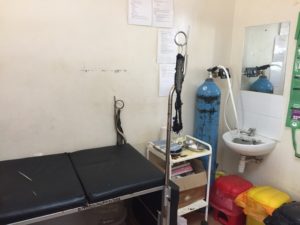
Blog by Charlotte Page, Ob/Gyn Resident:
This is a follow-up post to “Patient Barriers to Cervical Cancer Prevention in Kenya”.
I’ve realized while in Kenya that there are a lot of things I take for granted in bathrooms in the US: running water, a toilet that flushes, toilet paper, soap, and electricity. If you’re missing one of these things, the restroom is that much more uncomfortable – or perhaps even unfunctional.
Similarly, small systems issues here in Kenya can inhibit women from receiving the healthcare they need. For the HPV-positive women in the study I’m working on, such problems can significantly increase the amount of time and effort required to get treated with cryotherapy, to the point that some women don’t obtain treatment at all.
To paint a picture: yesterday I was at Migori County Referral Hospital (MCRH), one of the sites where cryotherapy is provided in our study. This procedure uses compressed gas to freeze precancerous cells on the cervix, thereby preventing them from progressing to cancer. It’s well-suited to low-resource settings since it doesn’t require electricity and can be performed in the clinic setting by a nurse (no doctor and no operating room required). Basically, all you need is the equipment for a pelvic exam (a speculum, an exam table, and a light), acetic acid, and gas.
There’s one cylinder of gas available for cryotherapy in all of MCRH. Fortunately, there was gas available that day, as it had been replaced the week prior (a process that takes a couple days). It turned out that neither of the two providers who normally provide cryotherapy were there. So, at 11 am, there were patients waiting for cryotherapy who had arrived around 7 am, but there was no provider. Fortunately, we tracked down a different provider who was trained in cryotherapy and was able to fill in since her primary clinic wasn’t busy.
I became her assistant. First, we had to locate a clean speculum. In the gynecology clinics where I work at Duke, I can always count on the nurses and certified medical assistants to keep the rooms stocked; here, on the other hand, there are no support staff, so providers are responsible for maintaining supplies themselves. After we located a speculum, we had to sterilize tips for the cryotherapy device. Fortunately, the treatment itself went smoothly. By the time the patient had been treated, she had been at MCRH for about six hours. Patients in the US would never be so patient!
That woman stuck it out until she got treated, but it doesn’t always end that way. Some women in our study have left treatment sites because there were no providers available to treat them, and others have been turned away due to lack of gas. Many of those who don’t get treated when they show up the first time won’t come back again.
In our study, the staff works to troubleshoot problems in real time so that every woman who comes gets treated. It’s far from perfect, though, and one of the long-term study objectives is to identify health systems factors that affect treatment rates so that future programs can be improved. Some of the challenges can be anticipated, but others don’t come to light until you’re in the thick of the moment, looking for a speculum.
